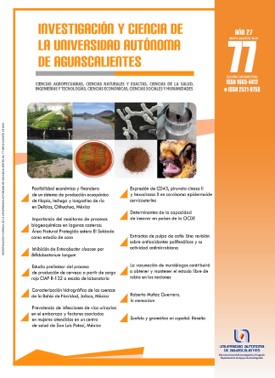Determinants of the capacity to innovate of the OECD members
DOI:
https://doi.org/10.33064/iycuaa2019772123Keywords:
national innovative capacity, generalized linear model, human capital, model, OECDAbstract
Innovation is one of the central issues that explain the economic performance of countries. However, not all nations have developed the capabilities needed to generate marketable innovations and take advantage of their benefits. This paper stands on the hypothesis that their institutions, their infrastructure, their human capital, their market sophistication and their business sophistication determine innovative capacity of OECD nations positively. The instrument used to measure these relationships was a Generalized Linear Model (GLM). Results suggest that three of five selected determinants are statistically significant. Findings reveal that business sophistication, followed by human capital and market sophistication has the greatest explanatory power of the model.
Downloads
Metrics
References
• Abdu, M., & Jibir, A. (2018). Determinants of firms innovation in Nigeria. Kasetsart Journal of Social Sciences, 39(3), 448-456.
• Andrews, D., Criscuolo, C., & Gal, P. N. (2015). Frontier firms, technology diffusion and public policy: micro evidence from OECD countries. Paris: OECD.
• Badiella, L. (2011). Modelos lineales generalizados mixtos: Algunos casos prácticos. En X Congreso Gallego de Estadística e Investigación de Operaciones. Pontevendra: Universidad de Vigo.
• Bianco, A. (2010). Modelo lineal generalizado. Buenos Aires: Universidad de Buenos Aires.
• Coy, P. (2015). The Bloomberg Innovation Index [Portal electrónico]. Recuperado de https://www.bloomberg.com/graphics/2015-innovative-countries/
• David, P. A., & Foray, D. (2002). An introduction to the economy of the knowledge society. International Social Science Journal, 54(171), 9-23. doi: 10.1111/1468-2451.00355
• De Ferranti, D. M., Perry, G. E., Gill, I., Guasch, L. J., Maloney, W. F., Sánchez-Páramo, C., & Schady, N. (2003). Closing the gap in education and technology. Washington, DC: The World Bank.
• Denison, E. F. (1985). Trends in American economic growth 1929-1982. Washington, DC: The Brookings Institution.
• Divisekera, S., & Nguyen, V. K. (2018). Determinants of innovation in tourism evidence from Australia. Tourism Management, 67, 157-167.
• Etzkowitz, H., & Leydesdorff, L. (2000). The dynamics of innovation: From National Systems and “Mode 2” to a Triple Helix of university-industry-government relations. Research Policy, 29, 109-123.
• Freeman, C. (1987). Technology, policy, and economic performance: Lessons from Japan. London: Pinter Publishers.
• Furman, J. L., Porter, M. E., & Stern, S. (2002). The determinants of national innovative capacity. Research Policy, 31(6), 899-933.
• Ginarte, J. C., & Park, W. G. (1997). Determinants of patent rights: A cross national study. Research Policy, 26(3), 283-301.
• Griliches, Z. (1979). Issues in assesing the contribution of research and development to productivity growth. Bell Journal of Economics, 10(1), 92-116.
• Grupo Banco Mundial. (2016). Indicadores del Desarrollo Mundial [Portal electrónico]. Recuperado de http://databank.bancomundial.org/data/reports.aspx?source=indicadoresdel-desarrollo-mundial
• Guan, J. C., Yam, R. C. M., Mok, C. K., & Ma, N. (2006). A study of the relationship between competitiveness and technological innovation capability based on DEA models. European Journal of Operational Research, 170(3), 971-986.
• Heijs, J., Martínez, M., Baumert, T., & Buesa Blanco, M., (2002). Los factores determinantes de la innovación: Un análisis econométrico sobre las regiones españolas. Economía Industrial, 347, 67-84.
• Hollanders, H., & Celikel Esser, F. (2007). Measuring innovation efficiency. Maastricht: Innometrics/University of Maastricht.
• Hottenrott, H., Hall, B., & Czarnitzki, D. (2016). Patents as quality signals? The implications for financing constraints on R & D. Economics of Innovation and New Technology, 25(3), 197-217.
• Hu, M. C., & Mathews, J. A. (2008). China’s national innovative capacity. Research Policy, 37(9). doi: 10.1016/j.respol.2008.07.003
• Khedhaouria, A., & Thurik, R. (2017). Configurational conditions of national innovation capability: A fuzzy set analysis approach. Technological Forecasting and Social Change, 120, 48-58.
• Leydesdorff, L. A., & Etzkowitz, H. (2003). Can “The Public” be considered as a fourth helix in university-industry-governmentrelations? Science and Public Policy, 30(1), 55-61.
• López-González, E., & Ruiz-Soler, M. (2011). Análisis de datos con el modelo lineal generalizado. Una aplicación con R. Revista Española de Pedagogía, 69(248), 59-80.
• Moori-Koenig, V., & Yoguel, G. (1998). El desarrollo de capacidades innovativas de las firmas en un medio de escaso desarrollo del sistema local de innovación. Río de Janeiro: Universidad Federal de Río de Janeiro.
• Morales, M., Ortiz Riaga, C. & Arias Cante, M. (2012). Factores determinantes de los procesos de innovación: Una mirada a la situación de Latinoamérica. Revista de la EAN, 72, 148-163.
• Organización para la Cooperación y el Desarrollo Económico. (2018). Sitio oficial de la Organización para la Cooperación y el Desarrollo Económico para México [Portal electrónico]. Recuperado de http://www.oecd.org/centrodemexico/inicio/
• Organización Mundial de la Propiedad Intelectual, Universidad de Cornell, & INSEAD (s. f.) Índice Global de Innovación 2013 [pdf descargable]. Recuperado de https://www.wipo.int/edocs/pubdocs/en/economics/gii/gii_2013.pdf
• __________ 2014 [pdf descargable]. Recuperado de https://www.wipo.int/edocs/pubdocs/en/economics/gii/gii_2014.pdf
• __________ 2015 [pdf descargable]. Recuperado de https://www.globalinnovationindex.org/userfiles/file/reportpdf/GII-2015-v5.pdf
• __________ 2016 [pdf descargable]. Recuperado de http://www.wipo.int/publications/es/details.jsp?id=4064
• __________ 2017 [pdf descargable]. Recuperado de https://www.insead.edu/sites/default/files/assets/dept/globalindices/docs/GII-2017-report.pdf
• __________ 2018 [pdf descargable]. Recuperado de https://www.globalinnovationindex.org/gii-2018-report
• Porter, M. E. (1990). The competitive advantage of nations. Harvard Business Review, March-April, 73-93.
• Powell, W. W., & Snellman, K. (2004). The Knowledge Economy. Annual Review of Sociology, 30, 199-220.
• Wu, J., Ma, Z., & Zhuo, S. (2017). Enhancing national innovative capacity: The impact of high-tech international trade and inward foreign direct investment. International Business Review, 26(3), 502-514.
• Wurlod, J. D., & Noailly, J. (2018). The impact of green innovation on energy intensity: An empirical analysis for 14 industrial sectors in OECD countries. Energy Economics, 71, 47-61.
Published
Versions
- 2019-05-31 (2)
- 2019-05-31 (1)
How to Cite
License
Copyright (c) 2019 Antonio Favila-Tello, Enrique Armas-Arévalos

This work is licensed under a Creative Commons Attribution-NonCommercial-ShareAlike 4.0 International License.
Las obras publicadas en versión electrónica de la revista están bajo la licencia Creative Commons Atribución-NoComercial-CompartirIgual 4.0 Internacional (CC BY-NC-SA 4.0)









